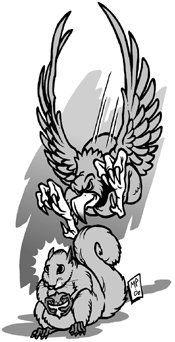Riebe, who has been practicing "The Art of Falconry" for about six years and will be demonstrating it this Saturday at the North Chagrin Nature Center, describes the sport as "training [raptors] to become unafraid of people, so they do what they would do on their own in the wild without the human present." For a red-tail, this means hunting rabbits and squirrels.
Likening falconry to bird-watching, Riebe says squirrels inspire the most aesthetically pleasing flights in the birds. "It's just a lot more acrobatic, because they're chasing something in the trees -- something that's running in a three-dimensional-type environment, rather than just flat on the ground," he explains. "So there's a lot more action and a lot more variety in the flights. Rabbits you often don't see much. You see the glimpse of a rabbit running though the grass, and then, off in the distance, you'll see the hawk coming in, and they both disappear."
As wild animals, hawks aren't easily persuaded to take human companions on the hunt. During the training process, the falconer earns the trust of the bird by offering food rewards. "Typically, pieces of rat meat or something like that," Riebe says. "Something very tasty -- to a red-tailed hawk."
But he emphasizes that this is not about keeping wild animals as pets. "They're not happy in captivity unless they're flown regularly, and even then I often feel guilty keeping a wild hawk in captivity."
Luckily, the bird can be safely returned to the wild, even after being flown with a falconer. "It quickly reverts back to its natural instincts, and they actually will regain their wariness of people pretty quickly."
So warn the squirrels: The hunt is on.


